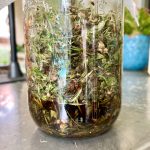To grow cosmos — a short introduction to this piece.
Cosmos are easy-to-grow annual flowers perfect for adding some low-maintenance color to your garden. These plants grow and flower best in full sun with at least six hours of direct light each day. They prefer well-drained soil, but don’t need nutrient-rich soil to thrive.
Sow seeds directly outside after the last frost or transplant seedlings once the soil warms. Space plants to avoid overcrowding (or thin seedlings). Water young plants to help them grow roots, then water less often once they are established.
Cosmos are drought-tolerant and do not like constantly wet soil, so the odd dry spell is ok. Remove faded flowers to keep the plants blooming. This encourages more blooms and keeps the plants looking tidy.
Preparing soil to grow cosmos
Pick a sunny spot with soil that drains well. Clear the area of weeds, rocks, and plant debris. Use a shovel or garden fork to loosen the top ~6 inches of soil. Mix in a bit compost to improve structure and add organic matter. Avoid adding too much compost or overly rich fertilizers, as cosmos grow best in soil that is not too fertile.
Break up large clumps and rake the soil flat to create a nice seed bed. Water the area lightly to help settle the surface. Make sure the soil stays loose and weed-free before planting.
Planting cosmos seeds
Wait until the soil has thawed and feels warm (not soggy and cold). Scatter cosmos seeds on the soil surface. Press the seeds gently into the soil with your hand or the back of a rake. Do not bury them deeply. You can cover them lightly with a bit of soil, but you can also just leave them on top of the soil as long as they are well in contact with the soil.
Water the area with a fine spray to avoid moving the seeds. Keep the soil moist until the seeds sprout. Thin the seedlings when they reach a few inches tall. For most cultivars, leave about a foot between plants so they have space to grow. Read the seed packet for specific details about different cultivars.
Planting cosmos seedlings
Choose healthy cosmos seedlings from the garden center with nice green leaves and no signs of stress. Wait until the risk of frost has passed before planting them outdoors.
Dig holes slightly larger than the seedling containers. Space the holes 12 to 18 inches apart to allow airflow between plants and give each seedlingroom to grow.
Gently remove the seedling from its container. If the roots are tightly circled around the outside, you can gently break them up and uncoil them. Place the roots in the hole at the same depth it grew in the pot. Fill in the soil around the roots and press firmly.
Water the seedlings well after planting. Keep the soil moist for the first week to help the roots settle.

Caring for cosmos plants in the garden
Water cosmos plants regularly during the first few weeks to help their roots grow strong. Once established, water only when the soil feels dry. Avoid overwatering, as cosmos prefer drier soil.
Skip the fertilizer unless your soil is very poor. Rich soil or added nutrients can lead to more leaves and fewer flowers.
Pinch off the top few inches of skinny young plants to encourage bushier growth. Thin seedlings or young plants if they are too close together and look like they are crowding each other. Give them space to grow and allow air to flow between them. Stake tall varieties in windy or rainy areas to keep them upright in inclement weather.
Keep an eye out for pests, though cosmos are usually low-maintenance and pest-resistant. Deadhead spent blooms to keep the plants flowering.


Cutting cosmos flowers for bouquets
Cut cosmos flowers for bouquets early in the morning before the heat of the day. Choose blooms that have just opened or are about to open. Regular harvesting encourages more blooms to grow.
Use clean, sharp floral snips or kitchen scissors to cut the stems above a leaf node. Remove the lower leaves that would sit below the waterline in a vase. Place the stems in a bucket of cool water right after cutting (bring it outdoors to the garden with you).
Let the flowers rest in water in a cool area for a few hours before arranging them. This helps them stay hydrated and last longer in bouquets and other floral arrangements.


Saving cosmos seeds
Cosmos seeds are among the easiest types of seeds to save. Let some cosmos flowers stay on the plant until they fade and form seed heads. Then wait until these seed heads dry out and turn brown.
Snip off the seed heads and place them in a paper bag or on a mesh tray/screen. Leave them to finish drying in a dry spot.
Once fully dry, rub the heads gently to separate the seeds. Store the seeds in a labeled envelope or airtight glass container. Seeds store best in a dark, dry place until planting season. Collected seeds are most likely to grow true to type when collected from single-color heirloom varieties grown in isolation from other cultivars.
To grow cosmos appears here to highlight key ideas for readers.














**Beneath the Sky’s Embrace**
Plant seeds where your heart finds its ease,
and water them with whispered dreams.
Let patience bloom in the tweed of time—
each sprout a heartbeat, green and meek.
Bask in the blush of crimson and rose,
as petals shiver in the sun’s gaze.
They ask for little, just breath and light,
yet teach the soul to hold what they give:
Not gold, but the glow of a field at dusk,
the weight of stars in a petal’s curve.
Let them wander, wild and uncurbed—
a hymn of forgetting, a root’s slow return.
And when frost comes, cold and keen,
let their seeds sleep, deep and sure,
as the story they’ve sown in the soil of your soul
winds louder than any name.